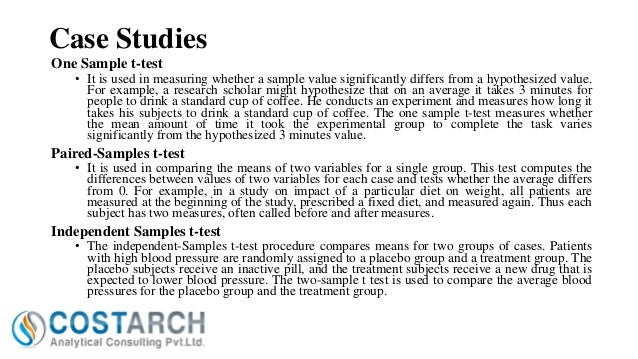

In addition, they can affect the statistical significance of the test. The problem with outliers is that they can have a negative effect on the dependent t-test, reducing the validity of your results. Outliers are simply single data points within your data that do not follow the usual pattern (e.g., in a study of 100 students' IQ scores, where the mean score was 108 with only a small variation between students, one student had a score of 156, which is very unusual, and may even put her in the top 1% of IQ scores globally). Assumption #3: There should be no significant outliers in the differences between the two related groups.

Nonetheless, to learn more about the different study designs that can be analysed using a dependent t-test, see our enhanced dependent t-test guide. The dependent t-test can also be used to compare different subjects, but this does not happen very often. The first related group consists of the subjects at the beginning of (prior to) the computerised spelling training and the second related group consists of the same subjects, but now at the end of the computerised training. You would like to know if the computer training improved their spelling performance. For example, you might have measured 10 individuals' performance in a spelling test (the dependent variable) before and after they underwent a new form of computerised teaching method to improve spelling. The reason that it is possible to have the same subjects in each group is because each subject has been measured on two occasions on the same dependent variable.

"Related groups" indicates that the same subjects are present in both groups. Assumption #2: Your independent variable should consist of two categorical, " related groups" or " matched pairs".You can learn more about continuous variables in our article: Types of Variable. Examples of variables that meet this criterion include revision time (measured in hours), intelligence (measured using IQ score), exam performance (measured from 0 to 100), weight (measured in kg), and so forth. Assumption #1: Your dependent variable should be measured on a continuous scale (i.e., it is measured at the interval or ratio level).First, let's take a look at these four assumptions: Even when your data fails certain assumptions, there is often a solution to overcome this.
#STATPLUS PAIRED T TEST HOW TO#
This is not uncommon when working with real-world data rather than textbook examples, which often only show you how to carry out a dependent t-test when everything goes well! However, don't worry. In practice, checking for these four assumptions just adds a little bit more time to your analysis, requiring you to click a few more buttons in SPSS Statistics when performing your analysis, as well as think a little bit more about your data, but it is not a difficult task.īefore we introduce you to these four assumptions, do not be surprised if, when analysing your own data using SPSS Statistics, one or more of these assumptions is violated (i.e., is not met). You need to do this because it is only appropriate to use a dependent t-test if your data "passes" four assumptions that are required for a dependent t-test to give you a valid result. When you choose to analyse your data using a dependent t-test, part of the process involves checking to make sure that the data you want to analyse can actually be analysed using a dependent t-test. However, before we introduce you to this procedure, you need to understand the different assumptions that your data must meet in order for a dependent t-test to give you a valid result. This "quick start" guide shows you how to carry out a dependent t-test using SPSS Statistics, as well as interpret and report the results from this test. If your dependent variable is dichotomous, you should instead use McNemar's test. For example, you could use a dependent t-test to understand whether there was a difference in smokers' daily cigarette consumption before and after a 6 week hypnotherapy programme (i.e., your dependent variable would be "daily cigarette consumption", and your two related groups would be the cigarette consumption values "before" and "after" the hypnotherapy programme). The dependent t-test (called the paired-samples t-test in SPSS Statistics) compares the means between two related groups on the same continuous, dependent variable. Dependent T-Test using SPSS Statistics Introduction


 0 kommentar(er)
0 kommentar(er)
